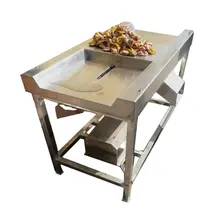Advancements in Extrusion Technology for Floating Fish Feed Production Techniques
Dec . 26, 2024 08:43 Back to list
Advancements in Extrusion Technology for Floating Fish Feed Production Techniques
Floating Fish Feed Extruder Revolutionizing Aquaculture
Aquaculture, the practice of breeding and raising fish in controlled environments, has gained immense popularity due to the increasing global demand for seafood. To support this growing industry, the development of efficient and high-quality fish feed is crucial. This is where the floating fish feed extruder comes into play, transforming the methods of fish feed production and enhancing the overall efficiency of aquaculture operations.
A floating fish feed extruder is a specialized machine designed to process raw materials into extruded fish feed pellets that float on water surfaces. Unlike traditional feed methods that often lead to feed wastage and water pollution due to sinking pellets, floating feed ensures that fish can easily access their food, which is not only cost-effective but also environmentally friendly.
How It Works
The process begins with the selection of raw materials, typically high-protein ingredients such as fish meal, soy protein, and various grains. These ingredients are mixed in precise proportions to achieve the desired nutritional profile. The mixture is then fed into the extruder, where it undergoes a series of processes—grinding, mixing, cooking, and shaping.
The extrusion process involves high pressure and temperature, which not only cooks the feed but also gelatinizes starches, enhancing digestibility. Once the mixture is adequately processed, it is forced through a die, forming pellets of specific sizes. These pellets can then be cut to the required length before being cooled and dried. The entire process is continuous, ensuring a high output of fish feed while maintaining quality.
Advantages of Floating Fish Feed
floating fish feed extruder

1. Reduced Feed Wastage One of the most significant advantages of floating fish feed is the reduction of feed wastage. Traditional sinking feeds often lead to leftover particles at the bottom of the aquarium or pond, contributing to water quality issues and increased costs. Floating feed, on the other hand, remains accessible to fish, allowing for better consumption rates and lower waste.
2. Improved Feed Conversion Ratio The floating nature of these pellets encourages fish to eat more readily, leading to improved growth rates. A better feed conversion ratio means that fish farmers can achieve optimal growth with less feed, thereby maximizing profitability.
3. Enhanced Nutritional Quality The extrusion process allows for better retention of nutrients. Extruded floating feeds can be formulated with essential vitamins and minerals that promote fish health and growth, catering to the specific dietary needs of various fish species.
4. Versatility and Customization Floating fish feed extruders can be tailored to produce different types of feed based on the target species. Whether it’s for tilapia, catfish, trout, or shrimp, the extruder can adjust parameters like temperature, pressure, and ingredient ratios to create the appropriate feed.
5. Environmental Benefits By reducing feed wastage and ensuring more efficient feeding, floating fish feed contributes to better water quality in aquaculture systems. This reduced environmental impact aligns with sustainable aquaculture practices, helping to address concerns about overfishing and habitat destruction.
Conclusion
The introduction of floating fish feed extruders represents a significant advancement in the aquaculture sector. By efficiently producing high-quality, floating pellets, these machines help fish farmers optimize their operations while catering to the nutritional needs of their aquatic stock. As global demand for seafood continues to rise, the role of innovative technologies like the floating fish feed extruder will be vital in ensuring the sustainability and profitability of the aquaculture industry. Fisheries around the world are likely to adopt this technology to enhance fish farming practices, contribute to food security, and ensure that the planet’s aquatic ecosystems remain healthy and productive for future generations.
-
Hot Sale 24 & 18 Door Rabbit Cages - Premium Breeding Solutions
NewsJul.25,2025
-
Automatic Feeding Line System Pan Feeder Nipple Drinker - Anping County Yize Metal Products Co., Ltd.
NewsJul.21,2025
-
Automatic Feeding Line System Pan Feeder Nipple Drinker - Anping County Yize Metal Products Co., Ltd.
NewsJul.21,2025
-
Automatic Feeding Line System - Anping Yize | Precision & Nipple
NewsJul.21,2025
-
Automatic Feeding Line System - Anping Yize | Precision & Nipple
NewsJul.21,2025
-
Automatic Feeding Line System-Anping County Yize Metal Products Co., Ltd.|Efficient Feed Distribution&Customized Animal Farming Solutions
NewsJul.21,2025






